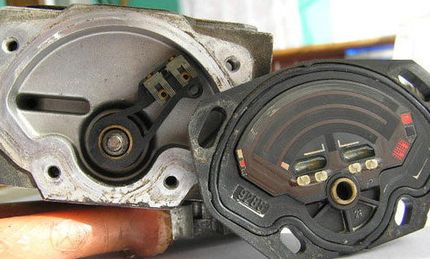
throttle sensor failure
Content
throttle sensor failure lead to unstable operation of the internal combustion engine of the car. That the TPS does not work correctly can be understood by the following signs: unstable idle, a decrease in the dynamics of a car, increased fuel consumption and other similar troubles. the basic sign that the throttle position sensor is faulty is the revving. And the main reason for this is the wear of the contact tracks of the throttle valve sensor. However, there are a number of others.
Checking the throttle position sensor is quite simple, and even a novice motorist can do it. All you need is an electronic multimeter capable of measuring DC voltage. If the sensor fails, it is most often impossible to repair it, and this device is simply replaced with a new one.
Signs of a Broken Throttle Position Sensor
Before proceeding to a description of the symptoms of a breakdown of the TPS, it is worth briefly dwelling on the question of what the throttle position sensor affects. you need to understand that the basic function of this sensor is to determine the angle by which the damper is turned. The ignition timing, fuel consumption, internal combustion engine power, and the dynamic characteristics of the car depend on this. Information from the sensor enters the electronic control unit ICE, and on its basis the computer sends commands about the amount of fuel supplied, the ignition timing, which contributes to the formation of an optimal air-fuel mixture.
Accordingly, breakdowns of the throttle position sensor are expressed in the following external signs:
- Unstable, "floating", idle speed.
- The internal combustion engine stalls during a gear change, or after switching from any gear to neutral speed.
- The motor can stall arbitrarily when idling.
- While driving, there are "dips" and jerks, namely, during acceleration.
- The power of the internal combustion engine is noticeably reduced, the dynamic characteristics of the car are falling. Which is very noticeable in terms of acceleration dynamics, problems when driving a car uphill, and / or when it is heavily loaded or towing a trailer.
- The Check Engine warning light on the instrument panel comes on (lights up). When scanning for errors from the ECU memory, the diagnostic tool shows an error p0120 or another associated with the throttle position sensor and breaks it.
- In some cases, there is an increased fuel consumption by the car.
It is also worth noting here that the signs listed above may also indicate problems with other internal combustion engine components, namely, a throttle valve failure. However, in the process of performing diagnostics, it is also worth checking the TPS sensor.
Reasons for the failure of the TPS
There are two types of throttle position sensors - contact (film-resistive) and non-contact (magnetoresistive). Most often, it is the contact sensors that fail. Their work is based on the movement of a special slider along resistive tracks. Over time, they wear out, which is why the sensor begins to give incorrect information to the ECU. So, causes of breakage of the film-resistive sensor may be:
- Loss of contact on the slider. This can be caused both simply by its physical wear and tear, or by a fragment of the tip. The resistive layer may simply wear out, due to which the electrical contact also disappears.
- The line voltage at the sensor output does not increase. This situation can be caused by the fact that the sputtering of the base has worn off almost to the base in the place where the movement of the slider begins.
- Worn slider drive gears.
- Broken sensor wires. These can be both supply and signal wires.
- A short in the electrical and / or signal circuit of the TP sensor.
Concerning magnetoresistive sensors, then they do not have deposition from resistive tracks, therefore, its breakdowns are reduced mainly to wire breakage or short circuit in their circuit... And the test methods for one and the other type of sensors are similar.
Be that as it may, repairing a failed sensor is hardly possible, so after performing the diagnostics, you simply need to replace it with a new one. In this case, it is desirable to use a non-contact throttle position sensor, since such an assembly has a much longer service life, although it is more expensive.
How to identify a broken throttle sensor
Checking the TPS itself is simple, and all you need is an electronic multimeter capable of measuring DC voltage. So, in order to check the breakdown of the TPS, you need to follow the algorithm below:
- Turn on the car ignition.
- Disconnect the chip from the sensor contacts and use a multimeter to make sure that power is coming to the sensor. If there is power, continue checking. Otherwise, you need to “ring out” the supply wires in order to find the place of the break or another reason why the voltage to the sensor is not suitable.
- Set the negative probe of the multimeter to ground, and the positive probe to the output contact of the sensor, from which the information goes to the electronic control unit.
- When the damper is closed (corresponds to a fully depressed accelerator pedal), the voltage at the output contact of the sensor should not exceed 0,7 Volts. If you fully open the throttle (fully depress the accelerator pedal), then the corresponding value should be at least 4 volts.
- then you need to manually open the damper (rotate the sector) and in parallel monitor the readings of the multimeter. They should slowly rise. If the corresponding value rises abruptly, then this indicates that there are frayed places in the resistive tracks, and such a sensor must be replaced with a new one.
Owners of domestic VAZs often face the problem of breakdown of the TPS due to the poor quality of the wires (namely, their insulation), which are standardly equipped with these cars from the factory. Therefore, it is recommended to replace them with better ones, for example, produced by CJSC PES/SKK.
And, of course, you need to check with an OBDII diagnostic tool. A popular scanner that supports most cars is Scan Tool Pro Black Edition. It will help you accurately find out the error number and see the parameters of the throttle, and also determine if the car also has problems, possibly in other systems.
Error codes 2135 and 0223
The most common error associated with the throttle position sensor has the code P0120 and stands for "breakage of the sensor / switch "A" throttle position / pedal". Another possible error p2135 is called "Mismatch in the readings of sensors No. 1 and No. 2 of the throttle position." The following codes may also indicate the incorrect operation of the DZ or its sensor: P0120, P0122, P0123, P0220, P0223, P0222. After replacing the sensor with a new one, it is imperative to erase the error information from the computer memory.
In the diagnostic application, the scanner will provide an opportunity to see the data coming from the sensor in real time robots. When moving the damper, you need to look at the readings in volts and the percentage of its opening. If the damper is in good condition, the sensor should give smooth values (without any jumps) from 03 to 4,7V or 0 - 100% with a fully closed or open damper. It is most convenient to watch the work of the TPS in graphical form. Sharp dips will indicate the wear of the resistive layer on the tracks of the sensor.
Hack and predictor Aviator
failure of the throttle position sensor - the failure is not critical, but it needs to be diagnosed and fixed as soon as possible. Otherwise, the internal combustion engine will operate under significant loads, which will lead to a reduction in its total resource. Most often, the TPS fails simply due to banal wear and tear and cannot be restored. Therefore, it just needs to be replaced with a new one.

